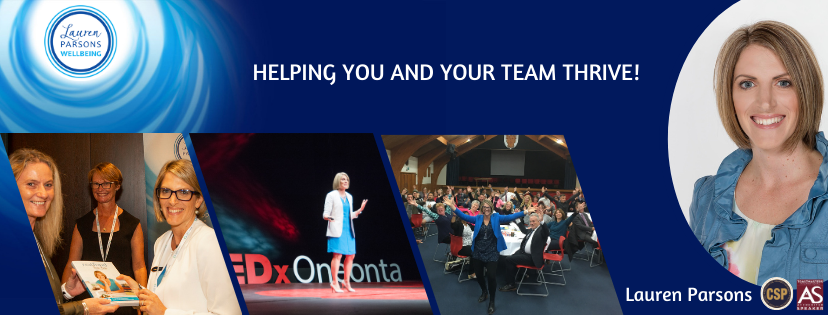An excerpt from Lauren Parsons’ book ‘Thriving Leaders Thriving Teams’.
“What you do speaks so loudly that I cannot hear what you say.”
– Ralph Waldo Emerson
I’ve created this simple, yet powerful DERT model of leadership. Yes, I’ll admit that phonetically, it may not sound like the best model, but we have been talking about cultivating the ‘good soil’ as the right workplace culture, haven’t we?
DERT MODEL OF LEADERSHIP
Leaders must constantly ask themselves, “What am I demonstrating, encouraging, reinforcing and tolerating that helps or hinders my staff to thrive?”
WHAT AM I DEMONSTRATING?
Your actions speak louder than words. Emotional intelligence and being aware of how you affect others is critical. As a leader, you cast a big shadow. Staff don’t want to be told what to do, they want a fantastic example to follow.
Rather than saying they should take breaks away from their desks, take the lead and do it yourself. If you expect staff to listen well, be an exceptional active listener. Want people to stick to time in meetings, share honest feedback, or express gratitude? Do those things well.
An HR leader in an IT company I worked with made a point of setting and communicating clear boundaries. Phillip told me he always took ‘loud lunch breaks’ (announcing he was getting out away from his desk) and did the same when he headed home.
Highly committed and happy to put in extra hours when required, he was also good at emphasising quality work over hours sitting at a desk. Phillip sent clear signals to his team about protecting and valuing their time. Often he’d head home early on a Friday, having completed his hours for the week and being on top of things. This gave permission to others to do the same.
Both Phillip’s staff and senior leadership raved about him. His team said they knew he expected them to dig deep when it was required, (and he always thanked them when they went the extra mile). They also felt he cared about them as people and helped them maintain life balance. Since taking over leading the IT team, not only had productivity increased, the team’s morale was higher and staff turnover dropped significantly.
WHAT AM I ENCOURAGING?
As well as what you do, it’s important to intentionally encourage others to follow your example. Spell it out for staff that working themselves to the point of burnout is not the goal. Encourage discussions in team meetings about healthy boundaries, how they recharge, and how they can best collaborate.
Make a point of highlighting people who maintain great life balance; this sends a clear message to the entire team.
I ran an ‘Optimistic October’ challenge for an organisation, encouraging their staff to form teams and tick off seven practical ways to build optimism throughout the month. The daily ideas included things like:
- Tell someone one thing you’re looking forward to today.
- Thank someone.
- Look at the top of the tallest tree and smile.
- Ask someone, ‘What’s been the best thing about your day?”
- Write down three things you’re grateful for.

One team leader started sharing photos such as, her group out for a walk pointing to a tall tree, smiling faces in their online meeting, thank you notes, and gratitude journal pages. Other teams got inspired and started sharing their own images. It created a lot of fun and connection right around the country. That one person’s initial action snowballed, encouraging others to follow suit.
WHAT AM I REINFORCING?

When you see or hear great examples of staff promoting their own or their colleagues’ wellbeing, shout it from the rooftops. Publicly praise and thank people for safeguarding their wellbeing. Make it known that you’re proud of people heading outdoors for walking meetings, starting their meetings with a mindful moment, or pushing back (politely and professionally) on unrealistic client expectations.
One day, Michigan-based web developer Madalyn Parker sent an out-of-office message to her colleagues which read, “Hey team, I’m taking today and tomorrow to focus on my mental health. Hopefully I’ll be back next week refreshed and back to 100%. Thanks Madalyn.”
Her CEO, Ben Congleton replied, “Hey Madalyn, I just wanted to personally thank you for sending emails like this. Every time you do, I use it as a reminder of the importance of using sick days for mental health – I can’t believe this is not standard practice at all organizations.”
Parker shared an image of the supportive reply on Twitter. It went viral, being flooded with positive comments, many from people interested in working for the organisation because of the example her CEO set.
WHAT AM I TOLERATING?
Be aware of what you tolerate. Small things are often indicators of bigger problems. If you know team members are turning up to work when they’re sick, you have team members who’ve barely taken annual leave in years, or you’re cc’d into late night emails bouncing back and forth, and you do nothing, you condone those behaviours.

Small issues can quickly grow if they’re neglected, just like weeds in a garden. Master gardeners know to weed regularly to stay on top of things before they become deeply rooted problems.
If you hear wellbeing shaming or witness other bullying or harassment, you need to take decisive action. There’s no such thing as an innocent bystander when it comes to leadership. Your role is to be an upstander and to clearly communicate what won’t be tolerated. When you don’t act you perpetuate and reinforce negative behaviours.
Positive Disruption

To make an impact and get away from the ‘caged-hen mentality’ so many workplaces unintentionally fall into, you need to do things differently. When you reflect on what underpins and influences wellbeing, and compare that to common practice in most organisations, there’s a big difference.
Our bodies are designed to move. Natural whole foods fuel our brains and improve moods. We do our most creative thinking when we’re active. Time outdoors in nature refreshes us. These things may be common sense, but they’re not common practice.
To truly influence wellbeing in your workplace, you must be prepared to stand out and go against the grain. Take action and be a positive disrupter.
When disruption happens to you, it can be uncomfortable, but when you lead positive disruption, it can be transformative. Choose to lead change in your organisation by managing your time differently, running meetings differently, connecting with staff differently, and you’ll see exponentially better results. This is aspirational leadership.
Culture expert, Gustavo Razzetti, says, “Your actions – what you reward and punish – is the standard that will define your team’s behaviours. Don’t just make statements; leaders need to behave boldly. The more risks you take, the more people will trust your words.”
I once did a leadership development session at a local council. During the breaks I played Pharrell Williams’ song ‘Happy’ a couple of times. A year later, a staff member explained that since that session, one of the senior leaders, would play ‘Happy’ on high volume across the atrium every Friday morning at 8.25am, just before the workday started.
She told me a few people didn’t enjoy it (out of over 200 people in the building), but the vast majority loved it! It brought a fantastic, energised vibe to the day. The practise still continues, even years later – a great example of positive disruption in action.
Enjoyed this article?
If you’d like to lift your leadership skills and discover how to create a thriving workplace culture, check out the Leading So People Thrive course and make a real difference as a leader.

About the Author – Lauren Parsons, CSP, AS
Lauren is a keynote speaker, author and consultant who’s passionate about helping busy people discover little-used techniques to boost their energy, vitality and performance. She’s the only speaker in the world to focus on lifting BOTH workplace wellbeing and productivity.
Awarded NZ Keynote Speaker of the Year and Educator of the Year 2023/24 by the Professional Speakers Association. Lauren is a sought-after international speaker, one of only a dozen Certified Speaking Professionals and the only Accredited Speaker in New Zealand.
TEDx speaker, Author of Thriving Leaders Thriving Teams and Real Food Less Fuss, Founder of the Snack on Exercise movement and host of the Thrive TV Show. With over 20 years’ experience, Lauren integrates her wellness and business background to help leaders find the sweet spot between boosting both wellbeing and productivity.
Described as unforgettable and life-changing, Lauren is a dynamic and highly-engaging presenter, and master story-teller who will have you laughing, moving and learning in a memorable way. Whether it’s virtual or in-person, you will leave Lauren’s session feeling uplifted and empowered to create positive change, today!
Based in the Manawatu, New Zealand, where she lives with her husband and three children, Lauren can often be found hosting dinner parties, playing board games, running, reading or getting out in her gumboots to walk the paddocks. She travels regularly to speak at conferences and in-house and specialises in helping leaders create positive, energised workplaces where people thrive.
Check out all the goodness at Lauren’s “Free Stuff” page at www.LaurenParsonsWellbeing.com

Ways to connect with Lauren
- Find out about conference keynotes
- See her most popular topics
- Make a time for a virtual cuppa over zoom
Share this Post
